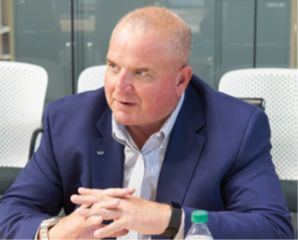通用汽车公司(General Motors)全球产品整合副总裁 Ken Morris 主管公司的动力总成业务,他对目前大肆宣传的电动推进系统发展趋势有一套独特观点。事实上,你可能想不到目前发动机业务仍是通用汽车公司的关键业务之一。最近,在接受《汽车工程》杂志的采访时,Morris 表示,“你随便看看现在的报道,可能会以为我们已经放弃(内燃)发动机,一切都要向电动推进系统迈进了,但事实上并非如此。”
Morris 表示,“在我看来,通用汽车公司正处于向电动推进系统转型的时期,而且就交易量而言,我们的转型速度可能没有你想象的那么快。IHS 数据显示,从现在起 10 年后,90%的发动机市场仍将是内燃机的天下。”
“然而,一旦真正优质的电动汽车开始大批量上市、相关充电基础设施开始呈现规模,到时候的情况你真的很难预测。”Morris 进一步补充说,“最后,你必须给客户提供他们想要的东西:燃油经济性、性能、质量和可靠性。无论是研发内燃发动机、混动汽车还是电动汽车, 这都是我们所有研发的终极目标。有人可能对电动汽车接受很快、有人可能由于工作需求对内燃发动机‘依依不舍’,这都是有可能的,我们要做的事就是为各种客户提供可以选择的菜单。”
内燃机时代行将终结?
然而,这并不意味着通用汽车对电气化未来的到来持怀疑态度。事实上,通用汽车已经针对电气化动力系统进行了大量投资。“我们在纯电动汽车上的资源投入翻了一倍,但并没有放弃内燃发动机工作。” Morris 解释说,“如今,我们正在开发两款全新的内燃发动机。市场对高性能、高能效的发动机总是有需求的。无论是开发全新的发动机型号,还是对现有发动机进行优化,毋庸置疑的是通用汽车的内燃发动机研发仍将持续数十年。”
“如今负责内燃发动机的机械工程师在纯电动推进系统研发中还有用武之地吗?”Morris 回答到,“我认为有,因为他们不仅技术专业而且经验丰富,已经在长期工作中证明了自己战胜新挑战的能力,他们肯定能帮上忙。”
平衡全球组合
“汽车是世界上最复杂的行业之一,”Morris 解释说,“作为一家全球汽车制造商,成功的关键就是时时刻刻、方方面面地做好准备。无论是全球任何一个市场,监管环境变化带来的影响远超燃料价格。你必须严格平衡在该地区的产品组合及相应销量,从而满足公司作为一个整体在该地区的合规需求。”
“例如,柴油发动机在中国的普及率非常、非常低。”Morris 补充说,“但这个市场对全球各地的影响却非常深远。过去,全球汽车行业的质心可能是欧洲和美国。但中国,特别是在纯电动汽车和混合动力汽车技术出现以来,正在推动全球汽车行业的变化。我研究过数据,柴油发动机的普及率在欧洲已经下降了,那还会反弹回来吗?”
内部研发与供应商合作
“俗话说的好,要不求人、要不求己,别无他法。我们必须为我们的车型寻找市场上最合适的解决方案,如果没有合适的,我们就自己开发一个。”Morris 当被问及原始设备制造商和供应商之间关系将如何变化时表示,“无论你如何进行整合、如何规划车辆功能、如何执行系统运作,但最关键的是车辆的灵魂不能改变,这也是通用汽车永远不会放弃的东西。”
“这也是决定各种汽车是否能在自动驾驶世界中脱颖而出的关键,”Morris继续道,“谁可以客户提供最佳体验?我认为,通用汽车从系统层面整合驾驶/操控、噪音/振动、转向/制动器的能力就是我们的一大优势。未来,到底是供应商帮我们供货?还是我们自己研发?这都不重要,重要的是如何将其恰到好处地融合在每一款汽车中,这才是通用汽车与众不同的地方。”
今天的挑战
在Morris 看来,每天最紧迫问题是什么?“我认为是内燃发动机,这是为所有纯电动汽车和自动驾驶汽车研发‘输血’的动力,以及这些产品的盈利性如何。我每天的目标:首先,是让通用汽车成为市场上最好的汽车,这是因为我们不能控制客户的购买决定,只能为客户提供更好的选择;其次,尽量提高车辆的能源效率,这不仅可以增加车辆的卖点,而且也是我们进入很多市场的先决条件;最后,我们还必须尽量提高这些车辆的盈利性,这样才能为未来的研发计划提供资金。”
Morris 作为全球汽车巨头通用汽车的掌门人之一,显然对未来汽车科技的发展趋势很有发言权,但他似乎理性地选择着眼当先。“人们很容易被新技术所迷惑,而忽略了目前的汽车行业也是每年可制造 1700 万到 1800 万辆汽车的巨轮。”Morris 解释说:“这种规模的行业需要大量设备、技术和人力的支持,新技术是在发展,我们也确实在前进,但传统车辆的动能仍不可忽视。”
As the VP of global product integrity at General Motors, Ken Morris oversees powertrain engineering, and has a first-hand view of the often ballyhooed trend of electrified propulsion. You might be surprised to learn that GM is, in fact, still very much in the engine business. “The way things are being covered right now, you would think we had just stopped everything, and everything is electric, and that certainly is not the way things are going to develop,” Morris said in a recent sit-down with Automotive Engineering.
“I would say GM's in transition, and the speed of that transition in terms of volumes is probably, you know, less huge than you would expect. IHS data says 90% still ICE 10 years from now,” Morris noted, referencing the respected industry analyst.
“But you never know what's going to happen when really good electric vehicles come out in volume, and the infrastructure starts coming around,” Morris said. “In the end you want to provide what the customers want: fuel economy, performance, quality, reliability. We're developing ICEs to match those, developing hybrids, developing electric vehicles. The key is to provide a kind of a menu. Some people are going to be early adopters and some people are going to be diesel diehards because that's a tool they need.”
End of the ICE age?
This does not mean that GM is doubtful of an electrified future, and it is investing accordingly. “We're doubling the number of resources that we have on BEVs, but we still have a tremendous amount of work to do on ICEs,” Morris explained. “We've got two brand-new engines in development right now. There's always going to be a need for really high-performance, high-efficiency engines. Doing that with new engines, or continuing to polish the stone on existing engines, we'll be in that business probably decades for sure.”
“Do I believe mechanical engineers can transfer those skill sets to help us on BEV propulsion systems?” Morris noted to the query. “I do. And that's the thing: It's not just good people, they're brilliant. They're experienced and they've been around the block multiple times. You definitely want to bring them along.”
Balancing the global mix
“The auto industry is the most complex industry in the world,” Morris explained. “The key to being a global automaker is you have to be prepared for whatever region you're trying to sell your vehicles in. The regulatory environment alone drives much more than fuel prices. What you need to do to meet the regulations in terms of what your mixes are, and how many you sell of each type of powertrain.”
“China for example, very, very low adoption of diesel,” Morris added. “And China is driving a lot of what's happening in the rest of the world. It used to be Europe and the United States as kind of the centroid of automotive technology. But China, especially along the lines of BEVs and hybrids and that technology, is driving that. I've looked at the numbers and the penetration rate of diesels has gone way down in Europe, and so does that bounce back?”
In-house and supplier expertise
“The saying is we'll either find a way or make a way. We're going to take the best solution that we can get for the vehicle, and if there isn't a good solution, were gonna make one.” Morris said when asked about the evolving relationship between OEMs and suppliers. “The key—and this is something that General Motors can never let out—is the soul of the vehicle and how you integrate all those things, and how does the vehicle function and how does it perform?”
“That's what's going to be the separator of vehicles in the AV world,” Morris continued. “Who's providing the best experience for the customer? I think our ability to integrate ride/handling, noise/vibration, steering/brakes has really come along as a company, and I think that's one of our strengths. It's a system exercise. The separation between what suppliers give us versus what we invent, that's going to be a case-by case basis. But how we dial that car in, that's us.”
Today's challenges
What does Morris see as the most pressing concerns facing him daily? “The motor that's going to fund all of the BEV and AV stuff are the IC engines and how profitable we are on our standards. My goal every day– number one – is to make those the best vehicles they can be, because people can buy anything they want. Then we have to make them as fuel-efficient as we can for selling points to customers, but also the regulatory environment. Lastly, we need to make as much money as we possibly can on these vehicles, because we want to fund the future.”
Morris is obviously in a thoughtful position to comment on future tech, but he appears rationally anchored in the present. “It's easy to get enamored with a new technology and forget what a massive industry we have making 17-, 18-million vehicles a year,” he explained. “There's a lot of equipment behind that, a lot of technology, a lot of people working on it. It's like an enormous ship. We're moving, and the technology is changing, but there's still a huge amount of momentum for the traditional vehicles.”
Author: Paul Seredynski
SAE Automotive Engineering
 通用汽车新型 2.7L “双蜗壳”涡轮增压 4 缸发动机将为公司的电气化未来投资“输血”。
通用汽车新型 2.7L “双蜗壳”涡轮增压 4 缸发动机将为公司的电气化未来投资“输血”。 “因为他们不仅技术专业而且经验丰富,已经在长期工作中证明了自己战胜新挑战的能力,他们肯定能帮上忙。”
“因为他们不仅技术专业而且经验丰富,已经在长期工作中证明了自己战胜新挑战的能力,他们肯定能帮上忙。”
